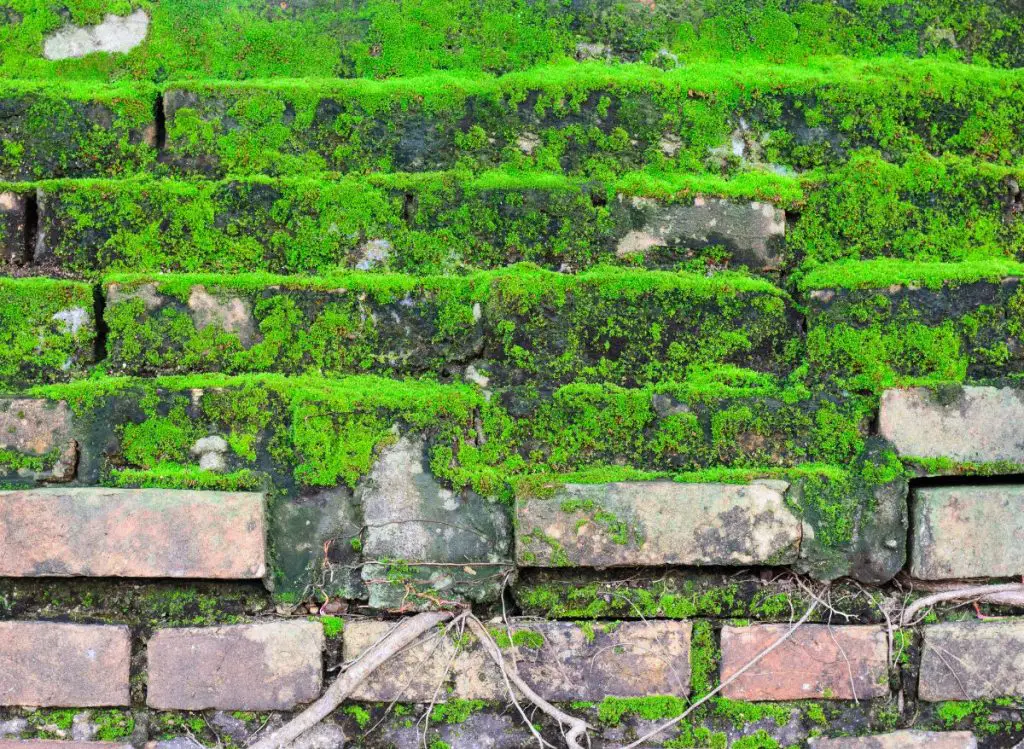The majority of people do not see moss growing as a way to improve indoor air quality. In reality, there are many benefits of growing moss. Whether or not you have an indoor garden in your home or business, you can easily incorporate a moss garden into any interior design.
Mosses are essential in landscaping and gardening, mainly peat moss (Sphagnum), according to Tulane University.
Consolidating a green wall or two is one of the household interior plan patterns, and here are eight Benefits of Growing Moss Indoors garden. You might also enjoy reading: Top 10 Benefits Of Growing Succulent Plants.

What Is a Moss?
Moss plants are flowerless and spore-producing plants (1). Mosses are classified as bryophytes, meaning non-vascular plants. While technically moss is a plant, it lacks some plant characteristics, including true leaves, branches, or even roots.
Generally, moss grows in damp, shady areas because moss does not have roots, and it must find other ways to absorb water. In addition, moss does not have seeds like many other plants do. It spreads by spore or division.
And moss tends to grow in colonies, with several plants growing closely together, creating a lovely, smooth, carpet-like appearance that makes moss gardens so beautiful.
See also: Best 13 Flowers Gardening Tips.
| Moisture | To thrive, moss requires a damp location. |
| Sun Exposure | Moss grows well in a shaded area because moisture is more likely to linger in these areas, and it will be less likely to dry out quickly. |
| pH | Moss prefers soil with higher acidity with a pH of about 5.5. |
| Soil requirements | Most mosses prefer compacted soil, particularly compacted clay soil. |
8 Benefits of Growing Moss
Growing moss offers tremendous benefits. Here are the top 8 advantages of growing moss.
1- Growing Moss Can Help Improve The Quality of Your Indoor Air
Household air pollution, also known as HAP, caused about 4.3 million deaths worldwide in 2012, according to the World Health Organization (WHO). Most of the deaths occurred in the Southeast Asian and Western Pacific parts, with 1.69 and 1.62 million deaths, respectively.
Adding moss to your home can improve the quality of the indoors through a process called biofiltration. The moss will capture and absorb air contaminants, then convert them to water and carbon dioxide, which will be released as fresh air.
The majority of property owners and business buildings fail to clean the HVAC systems regularly. As a result, having mossy green wall plants can help to purify the air.
2- Growing Moss Promotes Workers’ Ability to Generate Ideas, Boost Creativity, and Increase Problem-Solving Skills.
Adding plants and flowers in workplaces promotes workers’ ability to generate ideas, boost creativity, and increase problem-solving skills, according to Texas A&M University.
An eight-month study asked workers to perform a series of problem-solving tasks in three everyday office environments:
- Office environments with plants and flowers,
- Office environments with abstract sculptures,
- And office environments with no decorations.
Both male and female participants showed more innovative thinking and generated more ideas and original solutions to problems with plants and flowers.
Men who participated in the study developed 15% more ideas when working in the plant and flower surroundings. Females developed more creative, flexible solutions to problems when plants and flowers were present.
3- Growing Moss Can Help Conserve Energy
Evapotranspiration makes the areas around moss walls cooler in the summer months. During the wintertime, moss walls provide an extra layer of insulation to indoor spaces, reducing heating costs.
Water moves through the moss and then evaporates into the surrounding atmosphere with evapotranspiration.
According to the United States Department of Energy, evapotranspiration from mosses and open water was twice higher than from other types of plants, including lichens and bare ground.
A vertical green moss wall functions as an additional layer of liner for any home or business. Because the moss effectively keeps the warmth or cold, it will not penetrate the structure.
Adding moss increased evaporation more than a free-water surface. With moss, evaporation increased to 92% after temperature increases, according to a study issued in the Journal of Hydrology.
As a consequence, your energy costs will be cheaper because you will not even use as much energy to heat or cool the building. As a result, it both saves the environment and helps individuals save money.
See also: Best 6 Indoor Plants that Better Clean the Air and Remove Toxins.
4- Low Maintenance Plant
Moss planting is the route to go if you’re looking for a low-maintenance option to grow without having to put in a lot of effort. It is one of the benefits of growing moss that it requires very little light and must be kept damp now and then by misting it with water.
Your water bill won’t go up, and you’ll only have to cut the moss once in a while because it grows at such a slow rate.
5- Moss Plants Can Help Lower Stress And Be More Productive
A study at Washington State University calculated stress levels in workers at different workstations.
The researchers discovered that participants working in environments with plants were 12 percent less stressed than participants working at workstations without plants.
In addition, workers felt attentive when the plants were present.
6- Appealing to the Eye
Finding anything stylistically pleasant to update or change your style layout is difficult. A vertical greenish glow of moss is inconspicuous enough not to be a flaw, yet it will stand out once you enter the space.
Because there are few colors and clear features in a moss garden, it may create a relaxing atmosphere.
See also: Is Fish Tank Water Healthy For Orchids?

7- Bring Color and Life to Your Homes and Offices
Any interior vertical plant adds a touch of life to your home or business, and moss plants are no exception. The moss garden is alive and well, working hard to remove pollutants from the air, protect your house, and provide aesthetic advantages.
There are many advantages of growing moss or integrating a moss plant into your home or business.
8- Growing Moss Can Add Beauty to Your Home
In addition to boosting creativity and productivity, adding moss to your rooms or offices will elevate your space.
Moss can be excellent decorative pieces for the outdoors too. Actively being in contact with indoor plants, like planting, touching, and smelling, can help reduce psychological and physiological stress, as found in a 2015 study issued in the Journal of Physiological Anthropology.
How to Grow an Indoor Moss Garden: What Are the Steps?
If you want to make an indoor moss garden, you’ll only need a few basic ingredients and put in a little work. Here are the steps you need to follow to create an indoor mosses garden successfully.
- To begin, you’ll need to start by growing moss in a suitable container. You may use transparent container jars, or you can just use indoor mossy garden terrarium jugs that are adequate.
- The moss will grow well in containers like plastic aquariums, containers, and glass vases. Moss needs moisture to survive; therefore, it will seek out a wet and warm habitat.
- The next step may be to investigate moss, which may be grown in an indoor environment. You may have a few mosses that have grown in your backyard.
- You’ll be able to discover your moss in the shady ranges and in zones with moist soil to call for assistance. You’ll also find a few types of moss that have been growing under one of your neighbors’ houses, from which you may collect many cuttings.
- Mosses will grow in any healthy soil that contains a large amount of sand, which can cause the surface to become unstable. If you’re cultivating forest moss in your indoor garden, don’t use garden soil as a substrate.
- Using a scoop to collect the mosses that have grown outside should be done with caution. Make sure that when you harvest a piece of moss, you only collect 1 inch of the growing medium with a patch.
- The moss’s root architecture must be safe. You may have to lay the cut area on a plastic plate to transfer the moss to your house.
- One-quarter of your container should be filled with moss, stones, and rocks. Half of the container should be filled with dirt. You may apply a light covering of peat moss to the top layer of the soil to help it grow in acidic circumstances.
- After you’ve created a soil layer, don’t compact it since moss prefers loose, uncompacted dirt. Place a moss piece on the underlying soil and press it down to ensure that it is properly seated on the top layer of the soil.
- Place the moss garden in a half-shaded location of your home without direct sunlight to get the maximum benefits of growing moss. Using a showering bottle filled with room temperature water, fog your moss garden regularly.
- The moss should be cleaned out clammy but not soaked with water since too much liquid will cause the moss to rot. Remember that you should only inspect your moss garden regularly to get an idea if it needs to be moistened.
See also: Do Brassica Plants Actually Flower? (Yes, and here’s how to Thrive!)
Does Moss Need Sunlight To Grow?
Like any plant, mosses need sunlight to generate energy to allow the moss to grow and reproduce. Even though moss has many differences from plants, including being flowers, rhizoids instead of roots, and their ability to propagate via spores.
Remember that moss obtains all of its nutrition from the sun and does not require soil to thrive. If you’re growing moss indoors, make sure it’s in a light, well-ventilated area. To carry out photosynthesis, all of the nutrients it requires, moss requires light.
Does Moss Reduce Humidity?
One of the more intriguing and useful characteristics of moss is its ability to take moisture from the air when the weather is hot and then release it when humidity is high.
Indeed the benefits of growing moss are huge. Everyone must plant this for the purification of indoor and outdoor air pollutants.
See also: Top 10 Amazing Benefits Of Succulent Plants.
Wrapping Up
Growing moss plants will provide you with many benefits, including cleaning the air, reducing stress, elevating the beauty of your home, reducing distraction, and improving productivity.
Check out this article about the 6 indoor plants that better clean the air and help you remove toxins.


